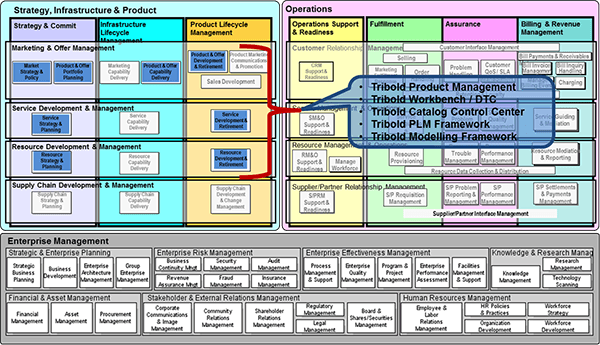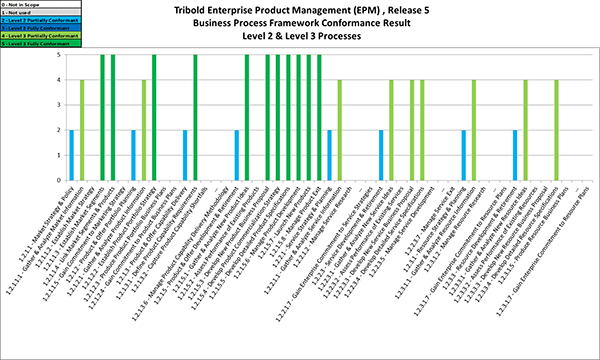Tribold has been acquired by Sigma Systems
![]() Company: Tribold
Company: Tribold
Product title and Version: Tribold Enterprise Product Management (EPM™), Release 5
Business Process Framework version: 8.0
Detailed Assessment Results: Sigma Tribold Enterprise Product Management Report
Product Overview
Tribold EPM™ is based on a Centralized Product and Service Catalog (CPC) and a Product and Service Lifecycle Management (PLM) solution. Dramatic improvements in product management performance enable CSPs to drive increased profit by reducing time-to-market, decreased cost-to- market, increased quality of the product management process and increased ability to support product and service innovation.
Tribold EPM Application Overview
Critical to the success of a Communication Service Provider’s (CSP) ability to operate profitably in an increasingly competitive and convergent marketplace is the ability to introduce and manage effectively a portfolio of products that are relevant to its customers, released at the most opportune time and done so at a low cost.
The Tribold solution is designed specifically to manage the end-to-end processes and product data relevant to a CSP’s product development, launch and in-life management activities. In doing so, Tribold enables true product management transformation for CSPs.
Tribold provides CSPs with the essential components of a full Product Lifecycle Management (PLM) framework and Product Data Management (PDM) capability. Tribold is an automated, packaged solution that asserts centralized business control over the product management process by becoming the Product Management platform central to the CSP’s enterprise.
The heart of Tribold EPM™ is the central product and service catalog, which brings together into a single master all of the commercial and technical elements that define the reusable product and service building blocks and resulting customer offers.
The Tribold user interface provides a single point of entry and single point of access to the master product and service data, through which users can perform all of the Product Lifecycle Management (PLM) processes necessary to centrally manage namely create, modify, delete, launch, maintain and retire) the full catalog of product offerings and underlying services and devices.
The open, standards and SOA based Tribold Integration Services Framework (ISF) provides the necessary Product Data Integration (PDI) infrastructure to interface product and service data to the BSS and OSS applications for example CRM, Billing, Order Management, SDP, Provisioning, Online Portals) in a structured, automated and efficient fashion.
Tribold EPM™ components:
- Tribold Product Portfolio Manager™ (PPM)
- Tribold Design Time Catalog™ (DTC)
- Tribold Catalog Control Center™ (CCC)
- Tribold Integration Services Framework™ (ISF)
- Tribold Connector Sets
TM Forum has reviewed and approved the self-certification of the product listed here against Business Process Framework (eTOM) version 8.0 processes elements. Each process element was measured using the Business Process Framework (eTOM) compliance scale.
Scope of Assessment – Business Process Framework Footprint
The following figure represents Business Process Framework Level 2 processes (blue background) that were presented in scope for the assessment, and the textual callouts represent the modules of the Tribold EPM™product that was assessed and that support the corresponding eTOM processes.
Product Conformance – Summary
Solution Conformance – with Comments
| Assessed eTOM Conformance | |||
| eTOM Process Element |
Assessed Domain | Conformance Level | Comment |
| Within Level 1: 1.2.1 – Marketing & Offer Management |
Product |
N/A (Level 1 Processes |
The following Level 2 process elements were assessed for this Level 1 process: 1.2.1.1 – Market Strategy & Policy 1.2.1.2 – Product & Offer Portfolio Planning 1.2.1.3 – Product & Offer Capability Delivery 1.2.1.5 – Product & Offer Development & Retirement |
|
Within Level 2: |
Product | Scope Partially Conformant (2) |
Partially Conformant
Three level 3 eTOM process elements have been assessed here for conformance, these are: These process elements have some detailed requirements that are not supported (see for each below). |
| 1.2.1.1.1 – Gather & Analyze Market Information | Product | Scope Partially Conformant (4) |
Partially Conformant
Some detailed requirements are not supported. |
| 1.2.1.1.3 – Establish Market Segments | Product | Scope Fully Conformant (5) |
Conformant
Note that the support provided can involve manual action facilitated by the automated support. |
| 1.2.1.1.4 – Link Market Segments & Products | Product | Scope Fully Conformant (5) |
Conformant
Note that the support provided can involve manual action facilitated by the automated support. |
| 1.2.1.2 – Product & Offer Portfolio Planning | Product | Scope Partially Conformant (2) |
Partially Conformant
Two level 3 eTOM processes have been assessed here for conformance, these are: These process elements have some detailed requirements that are not supported (see for each below). |
| 1.2.1.2.1 – Gather & Analyze Product Information | Product | Scope Partially Conformant (4) |
Partially Conformant
Some detailed requirements are not supported. |
| 1.2.1.2.2 – Establish Product Portfolio Strategy | Product | Scope Fully Conformant (5) |
Conformant
Note that the support provided can involve manual action facilitated by the automated support. |
| Within Level 2: 1.2.1.3 – Product & Offer Capability Delivery |
Product | Scope Partially Conformant (2) |
Partially Conformant
One level 3 eTOM process element has been assessed here for conformance, this is: Not all contained Level 3 process elements are in scope for the assessment. |
| 1.2.1.3.1 – Define Product Capability Requirements | Product | Scope Fully Conformant (5) |
Conformant
Some potential interactions are not relevant. |
| Within Level 2: 1.2.1.5 – Product & Offer Development & Retirement |
Product | Scope Partially Conformant (2) |
Partially Conformant
Seven level 3 eTOM process elements have been assessed here for conformance, these are: Not all contained Level 3 process elements are in scope for the assessment. |
| 1.2.1.5.1 – Gather & Analyze New Product Ideas | Product | Scope Fully Conformant (5) |
Conformant
Note that the support provided can involve manual action facilitated by the automated support. |
| 1.2.1.5.3 – Develop New Product Business Proposal | Product | Scope Fully Conformant (5) |
Conformant
Note that the support provided can involve manual action facilitated by the automated support. |
| 1.2.1.5.4 – Develop Product Commercialization Strategy | Product | Scope Fully Conformant (5) |
Conformant
Note that the support provided can involve manual action facilitated by the automated support. |
| 1.2.1.5.5 – Develop Detailed Product Specifications | Product | Scope Fully Conformant (5) |
Conformant
Note that the support provided can involve manual action facilitated by the automated support. |
| 1.2.1.5.6 – Manage Product Development | Product | Scope Fully Conformant (5) |
Conformant
Note that the support provided can involve manual action facilitated by the automated support. |
| 1.2.1.5.7 – Launch New Products | Product | Scope Fully Conformant (5) |
Conformant
Note that the support provided can involve manual action facilitated by the automated support. |
| 1.2.1.5.8 – Manage Product Exit | Product | Scope Fully Conformant (5) |
Conformant
Note that the support provided can involve manual action facilitated by the automated support. |
| Within Level 1: 1.2.2 Service Development & Management |
Service | N/A
(Level 1 Processes |
The following Level 2 process elements were assessed:
1.2.2.1 – Service Strategy & Planning |
| Within Level 2: 1.2.2.1 – Service Strategy & Planning |
Service | Scope Partially Conformant (2) |
Partially Conformant
One level 3 eTOM process element has been assessed here for conformance, this is: Not all contained Level 3 process elements are in scope for the assessment. |
| 1.2.2.1.1 – Gather & Analyze Service Information | Service | Scope Fully Conformant (5) |
Conformant
Note that the support provided can involve manual action facilitated by the automated support. |
| Within Level 2: 1.2.2.3 – Service Development & Retirement |
Service | Scope Partially Conformant (2) |
Partially Conformant
Three level 3 eTOM process elements have been assessed here for conformance, these are: Not all contained Level 3 process elements are in scope for the assessment. |
| 1.2.2.3.1 – Gather & Analyze New Service Ideas | Service | Scope Fully Conformant (5) |
Conformant
Note that the support provided can involve manual action facilitated by the automated support. |
| 1.2.2.3.3 – Develop New Service Business Proposal | Service | Scope Fully Conformant (5) |
Conformant
Note that the support provided can involve manual action facilitated by the automated support. |
| 1.2.2.3.4 – Develop Detailed Service Specifications | Service | Scope Fully Conformant (5) |
Conformant
Note that the support provided can involve manual action facilitated by the automated support. |
| Within Level 2: 1.2.3.1 – Resource Strategy & Planning |
Resource | Scope Partially Conformant (2) |
Partially Conformant
One level 3 eTOM process elements has been assessed here for conformance, this is: Some detailed requirements are not supported. |
| 1.2.3.1.1 – Gather & Analyze Resource Information | Resource | Scope Partially Conformant (4) |
Partially Conformant
Some detailed requirements are not supported. |
| Within Level 2: 1.2.3.3 – Resource Development & Retirement |
Resource | Scope Partially Conformant (2) |
Partially Conformant
Two level 3 eTOM process elements have been assessed here for conformance, these are: Not all contained Level 3 process elements are in scope for the assessment. |
| 1.2.3.3.1 – Gather & Analyze New Resource Ideas | Resource | Scope Fully Conformant (5) |
Conformant
Note that the support provided can involve manual action facilitated by the automated support. |
| 1.2.3.3.4 – Develop Detailed Resource Specifications | Resource | Scope Fully Conformant (5) |
Conformant
Note that the support provided can involve manual action facilitated by the automated support. |
Report Misuse: Frameworx conformance is an important part of enabling the communications industry maintain profitability as it migrates to new services and new business models. Gaining the conformance mark represents a significant investment by both suppliers and service providers. If you feel a company is misusing the conformance mark then please let us know at[email protected].
Disclaimer: TeleManagement Forum has conducted no independent testing of the product for compliance with its frameworks or standards. Such testing has solely been conducted by the supplier or seller of the product and has been self-certified by the supplier or seller for adherence to the TeleManagement Forum framework or standard in question. Accordingly, under no circumstances will TeleManagement Forum be liable for any direct or indirect damages or any costs or losses resulting from the the use or reliance by any party of or upon such certification.

